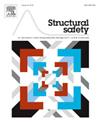基于机器学习的公路桥梁确定性、部分概率和全概率地震弹性评估方法
IF 6.3
1区 工程技术
Q1 ENGINEERING, CIVIL
引用次数: 0
摘要
公路桥梁是地震灾害的关键生命线,但在其弹性评估中平衡计算效率和建模保真度仍然是一个持续的挑战。本研究开发了一个机器学习(ML)辅助框架,集成了三种多保真度方法——确定性(DT)、部分概率(PP)和完全概率(FP)——以实现高速公路桥梁的地震弹性快速量化。对四种ML算法进行了严格的优化和比较,其中随机森林算法在预测工程需求参数(EDPs)(如柱漂移比、轴承位移和关节运动)方面最为有效。基于随机森林的代理模型,通过Zenodo公开共享,在保持准确性的同时显着降低了计算成本。一个案例研究表明,DT方法虽然计算精益,但由于忽略了结构损伤评估和恢复模型参数的不确定性,低估了恢复时间,特别是在强激励下。FP方法综合了损伤和修复的不确定性,实现了最高的保真度,但具有较高的计算成本和技术要求。PP方法在使用确定性修复模型的同时,通过概率评估损伤来平衡准确性和效率。分层DT-PP-FP方法为从业者提供了各种精度,数据可用性和资源约束的适应性工具,通过ml驱动的效率和概率严谨性推进桥梁的地震恢复力评估。本文章由计算机程序翻译,如有差异,请以英文原文为准。
Machine learning-aided deterministic, partially probabilistic, and fully probabilistic seismic resilience assessment methods for highway bridges
Highway bridges are critical lifelines vulnerable to seismic hazards, yet balancing computational efficiency and modeling fidelity in their resilience assessment remains a persistent challenge. This study develops a machine learning (ML)-aided framework integrating three multi-fidelity methods—deterministic (DT), partially probabilistic (PP), and fully probabilistic (FP)—to enable rapid seismic resilience quantification for highway bridges. Four ML algorithms are rigorously optimized and compared, with Random Forests emerging as the most effective for predicting engineering demand parameters (EDPs) such as column drift ratios, bearing displacements, and joint movements. The Random Forests-based surrogate models, publicly shared via Zenodo, significantly reduce computational costs while maintaining accuracy. A case study reveals that DT methods, while computationally lean, underestimate restoration time particularly under strong excitations due to the neglection of uncertainties in structural damage evaluation and restoration model parameters. The FP method integrates uncertainties in damage and restoration, achieving the highest fidelity but with computational costs and technical requirements. The PP method balances accuracy and efficiency by probabilistically evaluating damage while using deterministic restoration models. The hierarchical DT-PP-FP approach provides practitioners with adaptable tools for diverse precision, data availability, and resource constraints, advancing seismic resilience assessment of bridges through ML-driven efficiency and probabilistic rigor.
求助全文
通过发布文献求助,成功后即可免费获取论文全文。
去求助
来源期刊

Structural Safety
工程技术-工程:土木
CiteScore
11.30
自引率
8.60%
发文量
67
审稿时长
53 days
期刊介绍:
Structural Safety is an international journal devoted to integrated risk assessment for a wide range of constructed facilities such as buildings, bridges, earth structures, offshore facilities, dams, lifelines and nuclear structural systems. Its purpose is to foster communication about risk and reliability among technical disciplines involved in design and construction, and to enhance the use of risk management in the constructed environment
 求助内容:
求助内容: 应助结果提醒方式:
应助结果提醒方式:


